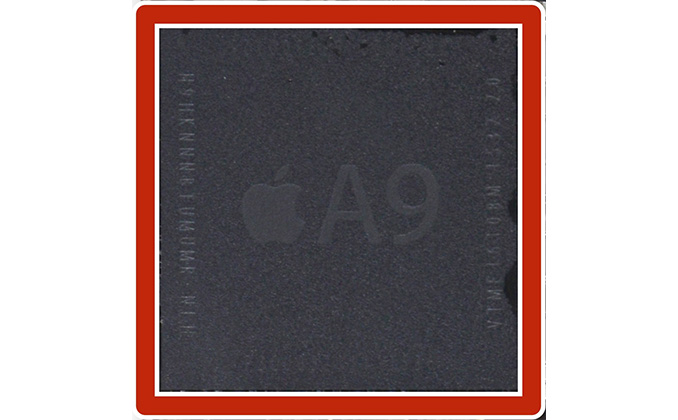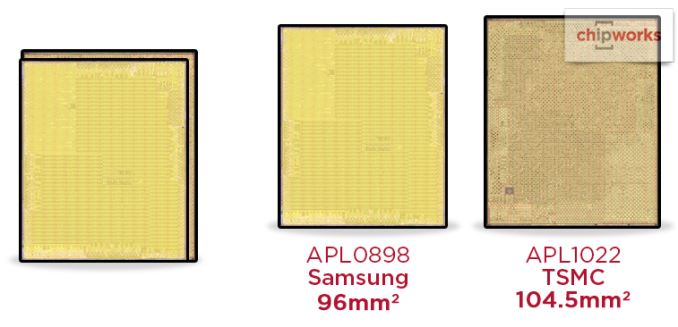Apple’s A9 SoC Is Dual Sourced From Samsung & TSMC
by Ryan Smith on September 28, 2015 7:00 PM EST
Picking up from our conversation this morning on Apple’s A9 SoC, the crew over at Chipworks has been working hard over the weekend to decap A9 and their first results are in. As it turns out, Chipworks has found chips fabbed by both TSMC and Samsung, which means that A9 is in fact a dual sourced part.
In taking apart iPhones and decapping SoCs, Chipworks has turned up two SoCs. The first, APL0898, is a 96mm2 A9 that’s fabbed by Samsung. The second SoC, APL1022, is a 104.5mm2 SoC fabbed by TSMC. And while Chipworks isn’t naming the specific manufacturing processes used, based on Apple’s comments on a “new transistor architecture,” we’re certainly looking at a form of FinFET. In which case the two chips are made on versions of Samsung’s 14nm FinFET and TSMC’s 16nm FinFET processes respectively.
This development is interesting for a few different reasons. From a fabrication standpoint, Samsung and TSMC have been brawling at multiple levels (technical and legal) to be the first to get a next-generation FinFET process out the door, with Samsung ultimately winning that battle when they shipped the 14nm Exynos 7420 for the Galaxy S6 family. For TSMC on the other hand this is as far as we know the first consumer product released with a 16nm TSMC fabbed part, indicating that TSMC is finally able to ship such parts in a reasonable volume.
More importantly, this is a huge move for Apple, and one we admittedly don’t have all of the facts about at this time. Dual sourcing parts is by no means a new concept – IBM requiring a second source of x86 chips is how AMD got started in the x86 industry, after all – but in more modern times dual sourcing of high performance parts is very rare due to how difficult and expensive it is. With dual sourcing essentially requiring the chip to be taped out twice – once for each fab – it requires significant financial and engineering resources, a cost that not very many companies besides Apple can take on without significant risk.
| Apple A9 SoC Versions | ||||
| APL0898 | APL1022 | |||
| Manufacturing Process | Samsung 14nm FinFET | TSMC 16nm FinFET | ||
| Die Size | 96mm2 | 104.5mm2 | ||
The big hurdle with dual sourcing a part such as a cutting-edge SoC like A9 is that unless the source fabs have designed their processes to be near identical – to form a common foundry specification – then different fabs will have different processes with different characteristics. This in turn is determined by the technical decisions a fab made in research and development, and the specific issues the fab ran into when bringing up the new process. The end result being that while two fabs can turn out chips based around the same design, those chips will not be identical. It’s this kind of inconsistency that chip customers like Apple have to tackle head-on if they want to go with dual sourcing.
Even at a physical level we can see this inconsistency right away in terms of die sizes. Despite the TSMC and Samsung processes being quite similar, the Samsung A9 is the smaller of the two by 8%, which as Chipworks notes is indicative of better density on Samsung’s 14nm node. What we don’t see, and the issue Apple really has to control for, is power consumption. Right now it’s a safe assumption that both chips can reach Apple’s required clockspeeds, so in order for Apple to utilize both in the iPhone 6s they need to make sure both perform as identically as possible, especially when it comes to idle power leakage and power consumption at different clockspeeds. The billion dollar question right now is whether either of the A9s is consistently better than the other one, and in which case by how much. For Apple it’s best that these chips are identical as possible – and they can make design choices when taping out the chip for each fab to help ensure this – but at the end of the day even Apple has to bow down to the laws of physics.
But the biggest unknown right now is why Apple would do this given the difficulties involved; to develop two A9s at twice the price. We can certainly speculate on reasons they would do this – yield issues at a fab, a desire to avoid putting all of their eggs in one basket and giving one fab too much power, or even just wanting to ramp up A9 production quickly by doubling the number of fabs working on it. But at the end of the day I don’t expect that’s a secret that will be known beyond the halls of One Infinite Loop, so speculation is all we have to work with for now.
In any case, if Apple has done their homework then dual sourcing A9s shouldn’t have an impact on average consumers, beyond perhaps ensuring that Apple has a sufficient supply to meet demand (ed: Apple sold 13mil iPhones in their opening weekend). Otherwise for techies, things are both more interesting and frustrating; just dual sourcing A9 makes an interesting product since this is something we almost never see done these days. As for the billion dollar question of which A9 is better, that will be a tossup. With enough time, effort, and a very large number of iPhones, it should be possible to coarsely determine if the A9s significantly differ in battery life, and thereby power consumption. However given the difficulties in taking an iPhone apart to access the A9, one would really need a software identification method to really make use of this information.
Source: Chipworks (A9 Shot Courtesy iFixit)












99 Comments
View All Comments
close - Tuesday, September 29, 2015 - link
Samsung sells the Exynos to other phone manufacturers, like Meizu. So there's a market for the lower binned parts. The Apple chips are Apple exclusive and I don't see them selling A9 chips to any other manufacturer.GodHatesFAQs - Tuesday, September 29, 2015 - link
Apple could use the lower binned parts for future iPod Touches, Apple TVs, etc. The new iPod Touch and Apple TV use the A8. It's not hard to imagine these are the lower binned chips made during the last year for iPhones.Wolfpup - Tuesday, September 29, 2015 - link
I don't think they're any different though, and Apple goes YEARS between releases on those products, for whatever reason.SunnyNW - Monday, September 28, 2015 - link
Also a question to someone more knowledgeable on the subject of die sizes and wafers. Is the die size difference big enough to produce more dies per wafer with the Samsung version than the TSMC version?I do understand yields play a roll in this but considering everything else being equal, not sure if the wafer costs are even equivalent or in the same ballpark but considering they were would the samsung Soc then be cheaper marginally for Apple, that is if the small size difference even would produce a good enough more chips per wafer...
Kristian Vättö - Tuesday, September 29, 2015 - link
The gross number of die (i.e. not taking partial dies on the edges and die spacings into account) is 736 for Samsung 14nm and 676 for TSMC 16nm.Samsung isn't necessarily cheaper, though, because it depends on Apple's contract with them. My guess is that the pricing is very close given that TSMC is competing against Samsung with their 16nm node, so despite it being slightly less cost efficient in terms of die size they must be competitive in price or otherwise everyone would go with Samsung/GF.
SunnyNW - Tuesday, September 29, 2015 - link
Thank You for the reply, that was very informative.psychobriggsy - Tuesday, September 29, 2015 - link
Work it out yourself: http://www.silicon-edge.co.uk/j/index.php/resource...You'll want 300mm wafers.
I get something like 620 dies for Samsung, and 510 for TSMC (although I estimated the height and width a bit as I only had the area to work from).
I don't know what the wafer processing cost is for FinFet on both nodes, but it is is $8K, then it costs $13 to make a die at Samsung, and $16 to make a die at TSMC. Of course, this is before yield takes effect, and yields could be widely different at each fab. Assuming 70% yield (it's a small die) at both for fairness, the cost goes to about $18 and $22 respectively. That's before you factor in packaging costs and R&D costs (but Apple sells so many chips that R&D per chip isn't actually major - a few dollars). The total cost of an A9, with 2GB LPDDR4 integrated in the final package, is probably under $40 each.
And you can adjust the maths if it turns out that wafer costs are higher/lower than my $8K estimate, or if we get more accurate yield numbers.
astroboy888 - Saturday, October 3, 2015 - link
It is the other way around. Apple orders number of wafers processed per month and don't order on per die basis. For example, Apple may buy 20,000 wafers each month from both TSMC and Samsung. The effective unit cost per die strictly depends on yield.Just because TSMC's die is slightly larger, it doesn't mean it is more expensive. If TSMC yield is higher, then cost per die would e lower than that of Samsung. In fact, I suspect TSMC yield was probably significantly better than Samsung during their trial run back in April. It could be the reason why we are seeing more TSMC dies in iPhones 6s/6s+ today.
cfenton - Monday, September 28, 2015 - link
How come Apple doesn't set up their own fabrication plant? Isn't that kind of vertical integration almost always beneficial in the long run? I understand that setting up a plant is extremely expensive, and that keeps smaller companies like AMD and Nvidia out, but surely Apple could afford it. Is it just cheaper for them to use their massive ordering power to get good deals from the existing fabs?Penti - Monday, September 28, 2015 - link
Why use their cash for this? Who would use a Apple fab except Apple? They are not really a semiconductor company just because they design their own SoC. How would they beat both TSMC and GloFo/Samsung? Who would they collaborate with on process? They have also decided to pay out some of their profits to the shareholders. Manufacturing takes investments and risk, now players in Taiwan and other parts of the world takes that risk and has big bank loans for the investment needed in order to fulfill their supply contracts with Apple.Most of Apples staff is in retail. In that sense they are unlike any other tech company.